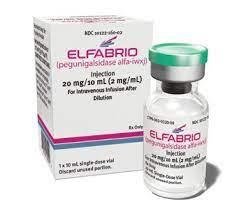Pegunigalsidase Alfa Dosage
Medically reviewed by Drugs.com. Last updated on Nov 9, 2023.
Applies to the following strengths: iwxj 2 mg/mL
Usual Adult Dose for:
Additional dosage information:
Usual Adult Dose for Fabry Disease
RECOMMENDED DOSING: 1 mg/kg (based on actual body weight) via IV infusion every 2 weeks
PRE-TREATMENT RECOMMENDATIONS:
- In enzyme replacement therapy (ERT)-experienced patients who pre-treated with antihistamines, antipyretics, and/or corticosteroids during prior ERT, consider a similar pre-treatment strategy before the first several infusions of this drug.
- After 4 to 6 well-tolerated infusions in ERT-experienced patients, consider a stepwise decrease in pre-treatment medication dose(s) and/or discontinuation.
- In ERT-naive patients, consider pre-treating with antihistamines, antipyretics, and/or corticosteroids prior to infusing this drug.
RECOMMENDED INFUSION RATES FOR INITIAL 4 TO 6 INFUSIONS:
ERT-Experienced Patients:
- Actual body weight less than 70 kg: 0.83 mL/min (50 mL/hr); total infusion volume: 150 mL
- Actual body weight 70 to 100 kg: 1.39 mL/min (83 mL/hr); total infusion volume: 250 mL
- Actual body weight greater than 100 kg: 2.78 mL/min (167 mL/hr); total infusion volume: 500 mL
- If infusion rate during prior ERT was greater than 3 hours: Maintain same rate of infusion with this drug.
- Consider decreasing duration of every third infusion by 30 minute decrements after first 4 to 6 doses.
- The minimum maintenance infusion duration is 1.5 hours.
ERT-Naive Patients:
- Actual body weight less than 70 kg: 0.63 mL/min (37.5 mL/hr); total infusion volume: 150 mL
- Actual body weight 70 to 100 kg: 1 mL/min (60 mL/hr); total infusion volume: 250 mL
- Actual body weight greater than 100 kg: 1.38 mL/min (83 mL/hr); total infusion volume: 500 mL
Comments:
- Appropriate medical support measures, including cardiopulmonary resuscitation equipment, should be readily available during administration of this drug.
- Home infusion under the supervision of a healthcare provider may be considered for patients who have reached an infusion duration that is well tolerated and constant.
- Infusion rate decreases should only be made in a healthcare facility setting.
Use: For the treatment of adults with confirmed Fabry disease
Renal Dose Adjustments
Data not available
Liver Dose Adjustments
Data not available
Precautions
US BOXED WARNING: Patients treated with this drug have experienced hypersensitivity reactions, including anaphylaxis. Appropriate medical support measures, including cardiopulmonary resuscitation equipment, should be readily available during administration of this drug. If a severe hypersensitivity reaction (e.g., anaphylaxis) occurs, discontinue this drug immediately and initiate appropriate medical treatment. In patients with severe hypersensitivity reaction, a desensitization procedure to this drug may be considered.
CONTRAINDICATIONS: None
Safety and efficacy have not been established in patients younger than 18 years.
Consult WARNINGS section for additional precautions.
Dialysis
Data not available
Other Comments
Administration advice:
- The manufacturer product information should be consulted prior to product administration.
- This drug should be given by IV infusion only.
- Use the recommended infusion rates based on actual body weight (ABW) for ERT-experienced or ERT-naive patients during the first 4 to 6 doses.
- Do not administer with other products in infusion tubing.
- After 4 to 6 well-tolerated infusions, the duration of every third infusion can be decreased by decrements of 30 minutes as tolerated.
- At infusion end, flush line with 0.9% sodium chloride using the same infusion rate used during the last part drug infusion.
Administration modifications for hypersensitivity or infusion-associated reactions (IARs):
FOR MILD OR MODERATE HYPERSENSITIVITY OR IARs:
- Consider temporarily holding the infusion for 15 to 30 minutes or slowing the infusion rate by 25% to 50%, and initiate appropriate medical treatment as required.
- If symptoms persist, stop infusion and monitor the patient. Consider re-initiating treatment again in 7-14 days at 25% to 50% of the infusion rate at which the reaction occurred; utilize appropriate pre-treatment.
- If symptoms subside after holding infusion, resume infusion at a 25% to 50% reduced rate as tolerated.
- If symptoms subside after slowing the infusion, complete infusion at the reduced rate as tolerated.
- Starting with next infusion, increase the rate by increments of 25% every third infusion as tolerated until the rate at which the original reaction occurred is reached; closely monitor patient.
FOR SEVERE HYPERSENSITIVITY (e.g., ANAPHYLAXIS) OR IARs:
- Discontinue this drug immediately and initiate appropriate medical treatment.
- Carefully consider the risks and benefits of re-administering this drug after severe reactions.
- Patients may be rechallenged using slower infusion rates and/or desensitization measures; once a patient tolerates infusion, rate may be increased to reach to recommended rate.
- Consult Warnings section for additional information on re-administration.
Missed dosing advice:
- If one or more doses are missed, restart treatment with this drug as soon as possible while maintaining the 2 week interval between infusions thereafter.
- Do not double a dose to compensate for a missed dose.
- In the case of a missed or delayed dose during home infusion, contact healthcare provider prior to next administration.
Storage requirements:
- Do not freeze or shake this drug.
- Store single-dose vials under refrigeration at 2C to 8C (36F to 46F).
- Diluted solution can be stored at room temperature between 20C to 25C (38 F to 77F) for up to 8 hours (inclusive of infusion time); discard if not used.
- Diluted solution can be refrigerated between 2C to 8C (36F to 46F) for up to 24 hours.
- Once diluted solution is removed from refrigeration, infuse within 8 hours (inclusive of infusion time); discard if not used.
Preparation techniques:
- The manufacturer product information should be consulted prior to product preparation.
- Allow vials to come to room temperature before use; do not use external heat source.
- Visually inspect vials for discoloration or particulate matter; discard if not clear or colorless.
- This drug must be diluted in 0.9% sodium chloride using a total infusion volume based on ABW as per dosing recommendations.
- Before dilution, remove from infusion bag a volume of 0.9% sodium chloride equal to the dosage volume of this drug.
- After injecting drug volume directly into diluent, gently invert infusion bag to mix; avoid vigorous agitation.
IV compatibility: Do not infuse this drug in the same intravenous line with other products.
Monitoring:
- Closely monitor patients during infusions for signs and symptoms of hypersensitivity or infusion-associated reactions.
Patient advice:
- Advise patients that reactions related to the infusion may occur, including anaphylaxis, or other serious hypersensitivity or infusion-associated reactions.
- Inform patients who are exposed to this drug during pregnancy that there is a Pregnancy Safety Study which monitors pregnancy outcomes.
More about pegunigalsidase alfa
- Check interactions
- Compare alternatives
- Reviews (1)
- Side effects
- During pregnancy
- Drug class: lysosomal enzymes
- Breastfeeding
- En español
Patient resources
Other brands
Professional resources
Other brands
Related treatment guides
See also:
Further information
Always consult your healthcare provider to ensure the information displayed on this page applies to your personal circumstances.


